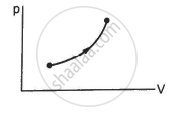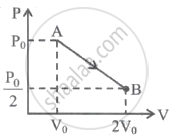Advertisements
Advertisements
Question
Estimate the fraction of molecular volume to the actual volume occupied by oxygen gas at STP. Take the diameter of an oxygen molecule to be 3Å.
Solution 1
Diameter of an oxygen molecule, d = 3 A = 3 x 10-10 m. Consider one mole of oxygen gas at STP, which contain total NA = 6.023 x 1023 molecules.
Actual molecular volume of `6.023 xx 10^23` oxygen molecules
`V_"actual" = 4/3 pir^3 . N_A`
`= 4/3 xx 3.14 xx (1.5)^3 xx 10^(-3) xx 6.02 xx 10^23 m^3`
`= 8.51 xx 10^(-6) m^3`
`= 8.51 xx 10^(-3) litre` [∵ `1 m^3 = 10^3 litre`]
:. Molecular volume of one mole of oxygen
`V_"actual" = 8.51 xx 10^(-3) litre`
At STP, the volume of one mole of oxygen
`V_"molar" = 22.4 litre`
`V_"actual"/"V_"molar" = 8.51 xx 10^(-3)/22.4" = 3.8 xx 10^(-4) ~~ 4 xx 10^(-4)`
Solution 2
Diameter of an oxygen molecule, d = 3Å
Radius, r = `d/2 = 3/2 ` = 1.5 Å = 1.5 × 10–8 cm
Actual volume occupied by 1 mole of oxygen gas at STP = 22400 cm3
Molecular volume of oxygen gas, `V = 4/3 pir^3. N`
Where, N is Avogadro’s number = 6.023 × 1023 molecules/mole
`:. V = 4/3 xx 3.14 xx (1.5 xx 10^(-8))^3 xx 6.023 xx 10^23 = 8.51 cm^3`
Ratio of the molecular volume to the actual volume of oxygen = `8.51/22400`
`= 3.8 xx 10^(-4)`
APPEARS IN
RELATED QUESTIONS
An air bubble of volume 1.0 cm3 rises from the bottom of a lake 40 m deep at a temperature of 12 °C. To what volume does it grow when it reaches the surface, which is at a temperature of 35 °C?
Calculate the mass of 1 cm3 of oxygen kept at STP.
The density of an ideal gas is 1.25 × 10−3 g cm−3 at STP. Calculate the molecular weight of the gas.
Use R=8.31J K-1 mol-1
Consider a sample of oxygen at 300 K. Find the average time taken by a molecule to travel a distance equal to the diameter of the earth.
Use R=8.314 JK-1 mol-1
Figure shows a vessel partitioned by a fixed diathermic separator. Different ideal gases are filled in the two parts. The rms speed of the molecules in the left part equals the mean speed of the molecules in the right part. Calculate the ratio of the mass of a molecule in the left part to the mass of a molecule in the right part.

Hydrogen gas is contained in a closed vessel at 1 atm (100 kPa) and 300 K. (a) Calculate the mean speed of the molecules. (b) Suppose the molecules strike the wall with this speed making an average angle of 45° with it. How many molecules strike each square metre of the wall per second?
Use R = 8.31 JK-1 mol-1
Work done by a sample of an ideal gas in a process A is double the work done in another process B. The temperature rises through the same amount in the two processes. If CAand CB be the molar heat capacities for the two processes,
The figure shows a process on a gas in which pressure and volume both change. The molar heat capacity for this process is C.

The molar heat capacity for the process shown in the figure is

One mole of gas expands obeying the relation as shown in the P-V diagram. The maximum temperature in this process is equal to ______.

